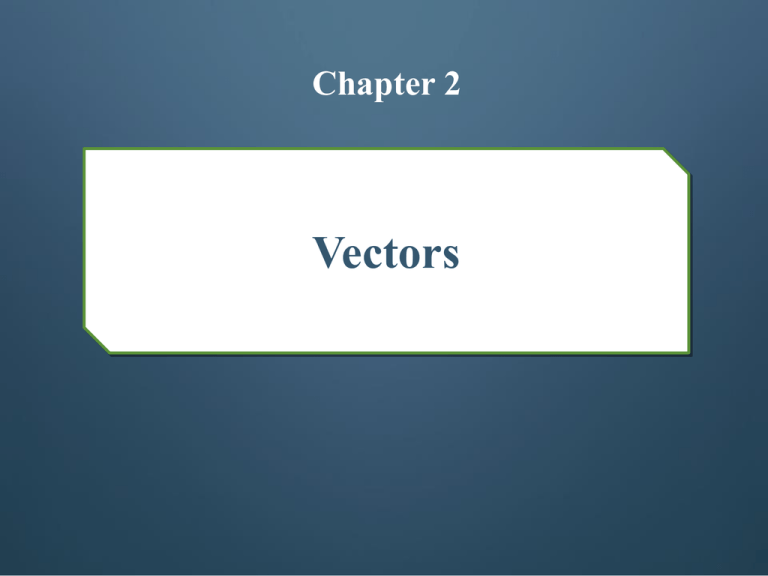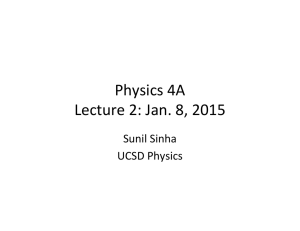
Chapter 2
Vectors
Scalars and vectors quantities:
Scalars and vectors :
A scalar quantity: is a quantity that has magnitude only. Mass, time,
speed, distance, pressure, Temperature and volume are all examples of
scalar quantities .
Note : Magnitude – A numerical value with units.
A vector quantity: is a quantity that has a magnitude and a direction.
One example of a vector is displacement , velocity , force,
acceleration
Note : Vectors are typically illustrated by drawing an ARROW above
the symbol. The arrow is used to express direction and magnitude.
Scalar Quantities and Vector Quantities
Scalar Quantities
Distance
Length without direction
Speed
How Fast an object moves
without direction
Examples
Vector Quantities
Examples
Displacement
Length with direction
Velocity
How Fast an object moves with
direction
Mass
How much Stuff is IN an object
60 N downward
Energy
Emits in All directions
Weight
Force due to gravity
Temperature
Average Kinetic Energy of an
object
Friction
Resistance force due to the
Surface conditions
Time
Acceleration
How Fast Velocity Changes over
Time
500 N
Always
downward
15 N
Against the
direction of
motion
Vectors and Their Components
The simplest example is a displacement vector
If a particle changes position from A to B, we represent this by
a vector arrow pointing from A to B
Figure 3-1
In (a) we see that all three arrows have
the same magnitude and direction: they
are identical displacement vectors.
In (b) we see that all three paths
correspond to the same displacement
vector. The vector tells us nothing about
the actual path that was taken between A
and B.
Vectors and Their Components
The vector sum, or resultant
o
o
Is the result of performing vector addition
Represents the net displacement of two or more displacement
vectors
Eq. (3-1)
o
Can be added graphically as shown:
Figure 3-2
Vectors and Their Components
Vector addition is commutative
o
We can add vectors in any order
Eq. (3-2)
Figure (3-3)
Vectors and Their Components
Vector addition is associative
o
We can group vector addition however we like
Eq. (3-3)
Figure (3-4)
Vectors and Their Components
A negative sign reverses vector
direction
Figure (3-5)
We use this to define vector
subtraction
Eq. (3-4)
Figure (3-6)
Vectors and Their Components
Components of vector in two dimensions can be found by:
Where θ is the angle the vector makes with the positive x
axis, and a is the vector length
The length and angle can also be found if the components
are known
Unit Vectors, Adding Vectors by Components
A unit vector
o
Has magnitude 1
o
Has a particular direction
Eq. (3-7)
o
Lacks both dimension and unit
Eq. (3-8)
o
Is labeled with a hat: ^
We use a right-handed coordinate system
o
Remains right-handed when rotated
Figure (3-13)
Example 1: Two vectors are given by 𝐴 = 3𝑖 − 2𝑗 𝑎𝑛𝑑 𝐵 = −𝑖 − 4𝑗 . Calculate :
𝐴 + 𝐵 = 3𝑖 − 2𝑗 + −𝑖 − 4𝑗 = 2𝑖 − 6𝑗
𝐴 − 𝐵 = 3𝑖 − 2𝑗 − −𝑖 − 4𝑗 = 4𝑖 + 2𝑗
The magnitude of 𝐴 + 𝐵 =
22 + (−62 ) = 6.32
The magnitude of 𝐴 − 𝐵 =
42 + (22 ) = 4.47
The direction of 𝐴 + 𝐵 𝑎𝑛𝑑 𝐴 − 𝐵
Solution :
𝐹𝑜𝑟 𝐴 + 𝐵, 𝜃 =
𝐹𝑜𝑟 𝐴 − 𝐵, 𝜃 =
𝑦
−1
tan
𝑥
𝑦
tan−1
𝑥
=
=
−6
−1
tan ( ) = −71.6°
2
2
tan−1 ( ) = 26.6°
4
Example 2:if 𝐴 = 4𝐼 + 6𝐽 + 2𝐾 , 𝐵 = 3𝐼 + 3𝐽 − 2𝐾 , 𝐶 = 𝐼 − 4𝐽 + 2𝐾
Find 𝑅(H.W.) .
Example 3: if 𝐴 = 5𝑖 + 3𝑗 − 6𝑘
𝐵 = 8𝑖 + 𝑗 − 4𝑘, Find
1. 𝐴 + 𝐵 = 13𝑖 + 4𝑗 − 10𝑘
2. 𝐴 − 𝐵 = −3𝑖 + 2𝑗 − 2𝑘
3. 𝐶 where 𝐶 = 2𝐴 − 3𝐵 = −14𝑖 + 3𝑗
4. The Magnitude and direction for 𝐶 .
The magnitude of 𝐶 is :
𝐶 =
(𝐶𝑥 )2 + (𝐶𝑦 )2 + (𝐶𝑧 )2 =
(−14)2 + (3)2 + (0)2 = 205
= 14.32
The angle (direction) that 𝐶 makes with the x-axis is :
𝜃=
𝐶𝑦
−1
tan
𝐶𝑥
=
tan−1
3
−14
= 𝐻. 𝑊.°
Example 4:Find 𝐴 + 𝐵 − 𝐶 for the given vectors :
𝐴 = 3𝑖 − 4𝑗 + 4𝑘
,
𝐵 = 2𝑖 + 3𝑗 − 7𝑘
𝑎𝑛𝑑 𝐶 = −4𝑖 + 2𝑗 + 5𝑘
Solution :
𝐴 + 𝐵 − 𝐶 = 3𝑖 − 4𝑗 + 4𝑘 + 2𝑖 + 3𝑗 − 7𝑘 − −4𝑖 + 2𝑗 + 5𝑘
𝐴 + 𝐵 − 𝐶 = 9𝑖 − 3𝑗 − 8𝑘
Example 5 (H.W.) :if 𝐴 = 3𝐼 − 4𝐽 , 𝐵 = −2𝐼 + 3𝐽 find
1. the angle between 𝐴 𝑎𝑛𝑑 𝐵
2.
3.
4.
5.
6.
7.
4𝐴
6𝐵
𝐴 +𝐵
𝐴 − 𝐵
𝐶𝑜𝑚𝑝𝑜𝑛𝑒𝑛𝑡 (magnitude)𝐴
𝐶𝑜𝑚𝑝𝑜𝑛𝑒𝑛𝑡 magnitude 𝐵
Multiplying Vectors
Multiplying a vector z by a scalar c
o
Results in a new vector
o
Its magnitude is the magnitude of vector z times |c|
o
Its direction is the same as vector z, or opposite if c is negative
o
To achieve this, we can simply multiply each of the components
of vector z by c
To divide a vector by a scalar we multiply by 1/c
Example : Multiply vector z by 5
o
z = -3 i + 5 j
o
5 z = -15 i + 25 j
Scalar product
Multiplying two vectors: the scalar product
o
o
o
Also called the dot product
Results in a scalar, where a and b are magnitudes and φ is the
angle between the directions of the two vectors:
A dot product : is the product of the magnitude of one vector
times the scalar component of the other vector in the direction of
the first vector
Scalar Product
The commutative law applies, and we can do the dot product in
component form
law applies, and we can do the dot product in component form
•
•
•
if A,B are parallel then the dot product of A,B are maximum
value .
if A,B are perpendicular then the dot product of A,B are zero
if A,B are anti-parallel then the dot product of A,B are
minimum value .
Scalar Product
Answer: (a) 90 degrees (b) 0 degrees (c) 180 degrees
Scalar Product
Example : two vectors are defined as :
𝐴 = 3𝑖 − 4𝑗 + 4𝑘
𝑎𝑛𝑑
𝐵 = 2𝑖 + 3𝑗 − 7𝑘
Find the following :
1) 𝐴. 𝐵
2) The angle 𝜃 between 𝐴 𝑎𝑛𝑑 𝐵 .
Solution :
1) 𝐴. 𝐵 = 𝐴𝑥 𝐵𝑥 + 𝐴𝑦 𝐵𝑦 + 𝐴𝑧 𝐵𝑧 = 3𝑖 − 4𝑗 + 4𝑘 . 2𝑖 + 3𝑗 − 7𝑘 = −34
2) 𝛉 = 𝐜𝐨𝐬 −𝟏
𝐀.𝐁
𝐀.𝐁
A =
(Ax )2 + (Ay )2 + (Az )2 =
(3)2 + (−4)2 + (4)2 = 6.4
B =
(Bx )2 + (By )2 + (Bz )2 =
(2)2 + (3)2 + (7)2 = 7.9
So the angle between the vectors A and B is
𝛉 = 𝐜𝐨𝐬 −𝟏
𝐀.𝐁
𝐀.𝐁
= 𝐜𝐨𝐬−𝟏
−𝟑𝟒
𝟔.𝟒×𝟕.𝟗
= 𝟏𝟑𝟐°
Scalar Product
HW:
Two vectors are defined as
A = (a – 5)î + a ĵ +2 ƙ
B = 2 î + 2 ĵ – 3a ƙ
if these two vectors are perpendicular , Calculate the
value of a ?(ans= -5 )
Multiplying Vectors (Vector product or cross product)
Multiplying two vectors: the vector product
o
The cross product of two vectors with magnitudes a & b,
separated by angle ϴ, produces a vector with magnitude
Eq. (3-24)
o
And a direction perpendicular to both original vectors
Direction is determined by the right-hand rule
A×B=C
A┴B┴C
Multiplying Vectors (Vector product or cross product)
© 2014 John Wiley & Sons, Inc. All rights reserved.
Multiplying Vectors
Figure (3-19)
The upper shows vector a cross vector b, the lower shows vector b cross vector a
Multiplying Vectors
The cross product is not commutative
Eq. (3-25)
To evaluate, we distribute over components:
Eq. (3-26)
Therefore, by expanding (3-26):
Eq. (3-27)
Multiplying Vectors
Example :three vectors are defined as :
𝐴 = 3𝑖 − 4𝑗 + 4𝑘
,
𝐵 = 2𝑖 + 3𝑗 − 7𝑘
𝑎𝑛𝑑
Determine :
1) 𝐴 × 𝐵
2) 𝐴 × 𝐵 . 𝐶
Solution :
1) 𝐴 × 𝐵
i
A×B= 3
2
j
k
−4 4 = 16i + 29j + 17k
3 −7
1) 𝐴 × 𝐵 . 𝐶 = 16i + 29j + 17k . −4𝑖 + 2𝑗 + 5𝑘
= 16 −4 + 29 2 + 17 5 = 79
𝐶 = −4𝑖 + 2𝑗 + 5𝑘
Multiplying Vectors
HW:
• Given two vector
A = 2i – 3j + k
B = -4i + j – 5k
Find a vector normal to both vectors A,B?
Summary
Scalars and Vectors
Adding Geometrically
Scalars have magnitude only
Vectors have magnitude and
direction
Both have units!
Eq. (3-2)
Eq. (3-3)
Vector Components
Unit Vector Notation
Given by
Eq. (3-5)
Obeys commutative and
associative laws
We can write vectors in terms of
unit vectors
Eq. (3-7)
Related back by
Eq. (3-6)
Summary
Adding by Components
Add component-by-component
Eqs. (3-10) - (3-12)
Scalar Product
Scalar Times a Vector
Product is a new vector
Magnitude is multiplied by
scalar
Direction is same or opposite
Cross Product
Dot product
Eq. (3-20)
Eq. (3-22)
Produces a new vector
perpendicular direction
in
Direction determined by righthand rule
Eq. (3-24)
Exercises (from book) : Page 62-63
1 , 2 , 3 , 4 , 9 , 10 , 11 , 30 .



